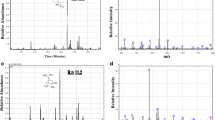Abstract
Although several species of the Synurophyceae have been associated with taste and odor problems in potable water supplies, electron microscopic-based field studies linked problematic blooms only toSynura petersenii Korshikov. Eventually, the organic compoundtrans-2,cis-6-nonadienal was implicated to cause the associated ‘cucumberlike’ odors. The objective of this study was to survey unialgal cultures of various Synurophycean species for the occurrence oftrans-2,cis-6-nonadienal. The compound was detected throughout a 24-day growth assay with aS. petersenii isolate, but was not detected in an identical assay withSynura sphagnicola (Korshikov) Korshikov. In separate 24-day cultures,trans-2,cis-6-nonadienal was detected in two isolates from theS. petersenii species complex, but was not detected in isolates of twoMallomonas or fourSynura taxa not from theS. petersenii complex. These results support the hypothesis that production oftrans-2,cis-6-nonadienal is unique to taxa within theS. petersenii complex. When contrast-enhancing optics and specific specimen preparation techniques are employed, light microscopy can be used to distinguish taxa in theS. petersenii complex from all other Synurophycean taxa. These methods are suggested as an efficient way to monitortrans-2,cis-6-nonadienal-producing taxa in potable water supplies.
Similar content being viewed by others
References
A.P.H.A. (1971) Standard Methods for the Examination of Water and Wastewater. 13th edn. American Public Health Assoc. 1015 18th St., Washington D.C., 874 pp.
Cassitas Municipal Water District (1987) Current methodology for the control of algae in surface reservoirs. American Water Works Assoc. III, 1–41.
Darley WM (1982) Algal Biology: A Physiological Approach. Blackwell Scientific Publications, Oxford, 168 pp.
Fogg GE (1975) Algal Cultures and Phytoplankton Ecology. The University of Wisconsin Press, Madison, 175 pp.
Hayes KP, Burch MD (1989) Odorous compounds associated with algal blooms in south Australian waters. Wat. Res. 23: 115–121.
Johnsen PB, Lloyd SW (1992) Influence of fat content on uptake and depuration of the off-flavor 2-methylisoborneol by channel catfish (Ictaluris punctatus). Can. J. Fish. aquat. Sci. 49: 2406–2411.
Korshikov AA (1929) Studies on the Chrysomonads. I. Arch. Protistenkd. 67: 253–290.
Kristiansen J (1981) Distribution problems in the Synuraceae (Chrysophyceae). Verb. Int. Ver. Limnol. 21: 1444–1448.
Kristiansen J (1986) The ultrastructural bases of chrysophyte systematics and phylogeny. Crit. Rev. Plant Sci. 4: 149–211.
Lehman JT (1976) Ecological and nutritional studies onDinobryon Ehr. seasonal periodicity and the phosphate toxicity problem. Limnol. Oceanogr. 21: 646–658.
Nicholls KH (1978) Jensen staining, a neglected tool in phycology. Trans. Am. Microsc. Soc. 97: 129–132.
Nicholls KH, Gerrath JF (1985) The taxonomy ofSynura (Chrysophyceae) in Ontario with special reference to taste and odour in water supplies. Can. J. Bot. 63: 1482–1493.
Siver P (1989) The distribution of scaled chrysophytes along a pH gradient. Can. J. Bot. 67: 2120–2130.
Smol J (1986) Chrysophycean microfossils as an indicator of lake-water pH. In: Smol JP, Battarbee RW, Davis RB, Merilaininen J. (eds), Diatoms and Lake Acidity. Dr W. Junk Publishers, Dordrecht: 275–287.
Takahashi E (1978) Electron Microscopical Studies of the Synuraceae (Chrysophyceae) in Japan. Tokai University Press, Tokyo, 194 pp.
Taylor WD, Wee JL, Wetzel RG (1986) A modification of the Utermohl sedimentation technique far improved identification and cell enumeration of diatoms and silica-scaled Chrysophyceae. Trans. Am. Microsc. Soc. 105: 68–72.
Wee JL (1981a) Laboratory and field studies on the Synuraceae (Chrysophyceae). Ph.D. dissertation. Iowa State Univ., 256 pp
Wee JL (1981b) Studies on the algal genusSynura Ehrenberg from Iowa using electron and light microscopy. Proc. Ia. Acad. Sci. 88: 70–73.
Wee JL (1982) Studies on the Synuraceae (Chrysophyceae) of Iowa. Bibliotheca Phycologia, Band 62, 183 pp. J. Cramer, Verlag Braunschweig, West Germany
Wee JL (1983) Specimen collection and preparation for critical light microscope examination of Synuraceae (Chrysophyceae). Trans. Am. Microsc. Soc. 102: 68–76.
Wink M (1990) Physiology of secondary product formation in plants. In Charlwood BV, Rhodes, MJC (eds), Secondary Products from Plant Tissue Culture. Clarendon Press, Oxford: 23–41.
Yano H, Nakahara, M, Ito, H. (1988) Water blooms ofUroglena americana and the identification of odorous compounds. Wat. Sci. Tech. 20: 75–80.
Author information
Authors and Affiliations
Additional information
Author for correspondence
Rights and permissions
About this article
Cite this article
Wee, J.L., Harris, S.A., Smith, J.P. et al. Production of the taste/odor-causing compound,trans-2,cis-6-nonadienal, within the Synurophyceae. J Appl Phycol 6, 365–369 (1994). https://doi.org/10.1007/BF02182152
Received:
Revised:
Accepted:
Issue Date:
DOI: https://doi.org/10.1007/BF02182152




